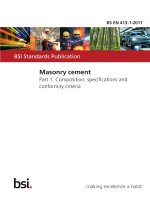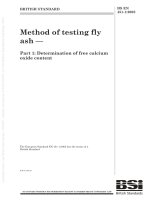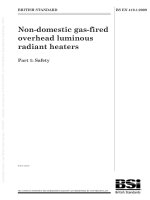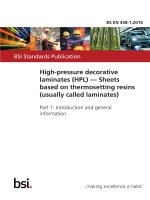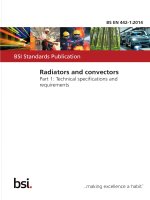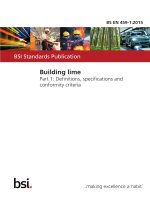Bsi bs en 61290 1 1 2015
Bạn đang xem bản rút gọn của tài liệu. Xem và tải ngay bản đầy đủ của tài liệu tại đây (1.14 MB, 18 trang )
BS EN 61290-1-1:2015
BSI Standards Publication
Optical amplifiers —
Test methods
Part 1-1: Power and gain parameters —
Optical spectrum analyzer method
BRITISH STANDARD
BS EN 61290-1-1:2015
National foreword
This British Standard is the UK implementation of EN 61290-1-1:2015. It
is identical to IEC 61290-1-1:2015. It supersedes BS EN 61290-1-1:2006
which is withdrawn.
The UK participation in its preparation was entrusted by Technical
Committee GEL/86, Fibre optics, to Subcommittee GEL/86/3, Fibre optic
systems and active devices.
A list of organizations represented on this committee can be obtained on
request to its secretary.
This publication does not purport to include all the necessary provisions of
a contract. Users are responsible for its correct application.
© The British Standards Institution 2015.
Published by BSI Standards Limited 2015
ISBN 978 0 580 83954 2
ICS 33.180.30
Compliance with a British Standard cannot confer immunity from
legal obligations.
This British Standard was published under the authority of the
Standards Policy and Strategy Committee on 31 July 2015.
Amendments/corrigenda issued since publication
Date
Text affected
BS EN 61290-1-1:2015
EUROPEAN STANDARD
EN 61290-1-1
NORME EUROPÉENNE
EUROPÄISCHE NORM
July 2015
ICS 33.180.30
Supersedes EN 61290-1-1:2006
English Version
Optical amplifiers - Test methods - Part 1-1: Power and gain
parameters - Optical spectrum analyzer method
(IEC 61290-1-1:2015)
Amplificateurs optiques - Méthodes d'essai Partie 1-1: Paramètres de puissance et de gain - Méthode
de l'analyseur de spectre optique
(IEC 61290-1-1:2015)
Prüfverfahren für Lichtwellenleiter-Verstärker Teil 1-1: Optische Leistungs- und Verstärkungsparameter Verfahren mit optischem Spektralanalysator
(IEC 61290-1-1:2015)
This European Standard was approved by CENELEC on 2015-06-11. CENELEC members are bound to comply with the CEN/CENELEC
Internal Regulations which stipulate the conditions for giving this European Standard the status of a national standard without any alteration.
Up-to-date lists and bibliographical references concerning such national standards may be obtained on application to the CEN-CENELEC
Management Centre or to any CENELEC member.
This European Standard exists in three official versions (English, French, German). A version in any other language made by translation
under the responsibility of a CENELEC member into its own language and notified to the CEN-CENELEC Management Centre has the
same status as the official versions.
CENELEC members are the national electrotechnical committees of Austria, Belgium, Bulgaria, Croatia, Cyprus, the Czech Republic,
Denmark, Estonia, Finland, Former Yugoslav Republic of Macedonia, France, Germany, Greece, Hungary, Iceland, Ireland, Italy, Latvia,
Lithuania, Luxembourg, Malta, the Netherlands, Norway, Poland, Portugal, Romania, Slovakia, Slovenia, Spain, Sweden, Switzerland,
Turkey and the United Kingdom.
European Committee for Electrotechnical Standardization
Comité Européen de Normalisation Electrotechnique
Europäisches Komitee für Elektrotechnische Normung
CEN-CENELEC Management Centre: Avenue Marnix 17, B-1000 Brussels
© 2015 CENELEC All rights of exploitation in any form and by any means reserved worldwide for CENELEC Members.
Ref. No. EN 61290-1-1:2015 E
BS EN 61290-1-1:2015
EN 61290-1-1:2015
European foreword
The text of document 86C/1309/FDIS, future edition 3 of IEC 61290-1-1, prepared by SC 86C "Fibre
optic systems and active devices" of IEC/TC 86 "Fibre optics" was submitted to the IEC-CENELEC
parallel vote and approved by CENELEC as EN 61290-1-1:2015.
The following dates are fixed:
•
latest date by which the document has to be implemented at
national level by publication of an identical national
standard or by endorsement
(dop)
2016-03-11
•
latest date by which the national standards conflicting with
the document have to be withdrawn
(dow)
2018-06-11
This document supersedes EN 61290-1-1:2006 and constitutes a technical revision.
EN 61290-1-1:2015 includes the following significant technical changes with respect to the previous
edition:
a) updates on the characteristics of measurement apparatus;
b) revised list of addressed optical amplifier parameters.
EN 61290-1-1:2015 shall be used in conjunction with EN 61290-1 and EN 61291-1.
Attention is drawn to the possibility that some of the elements of this document may be the subject of
patent rights. CENELEC [and/or CEN] shall not be held responsible for identifying any or all such
patent rights.
Endorsement notice
The text of the International Standard IEC 61290-1-1:2015 was approved by CENELEC as a
European Standard without any modification.
In the official version, for Bibliography, the following notes have to be added for the standards indicated:
2
IEC 61290-10
NOTE
Harmonized in EN 61290-10 series (not modified).
IEC 60793-2-50
NOTE
Harmonized as EN 60793-2-50.
BS EN 61290-1-1:2015
EN 61290-1-1:2015
Annex ZA
(normative)
Normative references to international publications
with their corresponding European publications
The following documents, in whole or in part, are normatively referenced in this document and are
indispensable for its application. For dated references, only the edition cited applies. For undated
references, the latest edition of the referenced document (including any amendments) applies.
NOTE 1
When an International Publication has been modified by common modifications, indicated by (mod),
the relevant EN/HD applies.
NOTE 2
Up-to-date information on the latest versions of the European Standards listed in this annex is
available here: www.cenelec.eu.
Publication
Year
Title
EN/HD
Year
IEC 61290-1
-
Optical amplifiers - Test methods Part 1: Power and gain parameters
EN 61290-1
-
IEC 61291-1
-
Optical amplifiers Part 1: Generic specification
EN 61291-1
-
3
–2–
BS EN 61290-1-1:2015
IEC 61290-1-1:2015 © IEC 2015
CONTENTS
FOREWORD ........................................................................................................................... 3
1
Scope .............................................................................................................................. 5
2
Normative references ...................................................................................................... 5
3
Terms, definitions and abbreviations ............................................................................... 5
3.1
Terms and definitions .............................................................................................. 5
3.2
Abbreviations .......................................................................................................... 5
4
Apparatus ........................................................................................................................ 6
5
Test sample ..................................................................................................................... 8
6
Procedure ........................................................................................................................ 8
7
Calculation ...................................................................................................................... 9
8
Test results ................................................................................................................... 11
Bibliography .......................................................................................................................... 12
Figure 1 – Typical arrangement of the optical spectrum analyzer test apparatus for
gain and power measurements ............................................................................................... 6
BS EN 61290-1-1:2015
IEC 61290-1-1:2015 © IEC 2015
–3–
INTERNATIONAL ELECTROTECHNICAL COMMISSION
____________
OPTICAL AMPLIFIERS – TEST METHODS –
Part 1-1: Power and gain parameters –
Optical spectrum analyzer method
FOREWORD
1) The International Electrotechnical Commission (IEC) is a worldwide organization for standardization comprising
all national electrotechnical committees (IEC National Committees). The object of IEC is to promote
international co-operation on all questions concerning standardization in the electrical and electronic fields. To
this end and in addition to other activities, IEC publishes International Standards, Technical Specifications,
Technical Reports, Publicly Available Specifications (PAS) and Guides (hereafter referred to as “IEC
Publication(s)”). Their preparation is entrusted to technical committees; any IEC National Committee interested
in the subject dealt with may participate in this preparatory work. International, governmental and nongovernmental organizations liaising with the IEC also participate in this preparation. IEC collaborates closely
with the International Organization for Standardization (ISO) in accordance with conditions determined by
agreement between the two organizations.
2) The formal decisions or agreements of IEC on technical matters express, as nearly as possible, an international
consensus of opinion on the relevant subjects since each technical committee has representation from all
interested IEC National Committees.
3) IEC Publications have the form of recommendations for international use and are accepted by IEC National
Committees in that sense. While all reasonable efforts are made to ensure that the technical content of IEC
Publications is accurate, IEC cannot be held responsible for the way in which they are used or for any
misinterpretation by any end user.
4) In order to promote international uniformity, IEC National Committees undertake to apply IEC Publications
transparently to the maximum extent possible in their national and regional publications. Any divergence
between any IEC Publication and the corresponding national or regional publication shall be clearly indicated in
the latter.
5) IEC itself does not provide any attestation of conformity. Independent certification bodies provide conformity
assessment services and, in some areas, access to IEC marks of conformity. IEC is not responsible for any
services carried out by independent certification bodies.
6) All users should ensure that they have the latest edition of this publication.
7) No liability shall attach to IEC or its directors, employees, servants or agents including individual experts and
members of its technical committees and IEC National Committees for any personal injury, property damage or
other damage of any nature whatsoever, whether direct or indirect, or for costs (including legal fees) and
expenses arising out of the publication, use of, or reliance upon, this IEC Publication or any other IEC
Publications.
8) Attention is drawn to the Normative references cited in this publication. Use of the referenced publications is
indispensable for the correct application of this publication.
9) Attention is drawn to the possibility that some of the elements of this IEC Publication may be the subject of
patent rights. IEC shall not be held responsible for identifying any or all such patent rights.
International Standard IEC 61290-1-1 has been prepared by subcommittee 86C: Fibre optic
systems and active devices, of IEC technical committee 86: Fibre optics.
This third edition cancels and replaces the second edition published in 2006 and constitutes a
technical revision.
This edition includes the following significant technical changes with respect to the previous
edition:
a) updates on the characteristics of measurement apparatus;
b) revised list of addressed optical amplifier parameters.
–4–
BS EN 61290-1-1:2015
IEC 61290-1-1:2015 © IEC 2015
The text of this standard is based on the following documents:
FDIS
Report on voting
86C/1309/FDIS
86C/1328/RVD
Full information on the voting for the approval of this standard can be found in the report on
voting indicated in the above table.
This publication has been drafted in accordance with the ISO/IEC Directives, Part 2.
This standard shall be used in conjunction with IEC 61290-1 and IEC 61291-1.
A list of all parts of the IEC 61290 series, published under the general title Optical amplifiers –
Test methods 1 can be found on the IEC website.
The committee has decided that the contents of this publication will remain unchanged until
the stability date indicated on the IEC website under "" in the data
related to the specific publication. At this date, the publication will be
•
reconfirmed,
•
withdrawn,
•
replaced by a revised edition, or
•
amended.
A bilingual version of this publication may be issued at a later date
—————————
1 The first editions of some of these parts were published under the general title Optical fibre amplifiers – Basic
specification or Optical amplifier test methods.
BS EN 61290-1-1:2015
IEC 61290-1-1:2015 © IEC 2015
–5–
OPTICAL AMPLIFIERS – TEST METHODS –
Part 1-1: Power and gain parameters –
Optical spectrum analyzer method
1
Scope
This part of IEC 61290 applies to all commercially available optical amplifiers (OAs) and
optically amplified modules. It applies to OAs using optically pumped fibres (OFAs based on
either rare-earth doped fibres or on the Raman effect), semiconductor OAs (SOAs) and planar
optical waveguide amplifiers (POWAs).
The object of this standard is to establish uniform requirements for accurate and reliable
measurements, by means of the optical spectrum analyzer test method, of the following OA
parameters, as defined in IEC 61291-1:
a) nominal output signal power;
b) gain;
c) polarization-dependent gain;
d) maximum output signal power;
e) maximum total output power.
NOTE
All numerical values followed by (‡) are suggested values for which the measurement is assured.
The object of this standard is specifically directed to single-channel amplifiers. For
multichannel amplifiers, one should refer to the IEC 61290-10 series [1] 2.
2
Normative references
The following documents, in whole or in part, are normatively referenced in this document and
are indispensable for its application. For dated references, only the edition cited applies. For
undated references, the latest edition of the referenced document (including any
amendments) applies.
IEC 61290-1, Optical amplifiers - Test methods - Part 1: Power and gain parameters
IEC 61291-1, Optical amplifiers - Part 1: Generic specification
3
Terms, definitions and abbreviations
3.1
Terms and definitions
For the purposes of this document, the terms and definitions given in IEC 61291-1 apply.
3.2
Abbreviations
ASE
amplified spontaneous emission
DBR
distributed Bragg reflector (laser diode)
DFB
distributed feed-back (laser diode)
—————————
2 Numbers in square brackets refer to the Bibliography
BS EN 61290-1-1:2015
IEC 61290-1-1:2015 © IEC 2015
–6–
ECL
external cavity laser (diode)
LED
light emitting diode
OA
optical amplifier
OFA
optical fibre amplifier
POWA
planar optical waveguide amplifier
SOA
semiconductor optical amplifier
4
Apparatus
A diagram of the measurement set-up is given in Figure 1.
Optical
source
J1
dB
Polarization
controller
(optional)
Optical
power
meter
Variable
optical
attenuator
IEC
Figure 1a – Calibration
Optical
source
J1
dB
J2
Polarization
controller
(optional)
Optical
spectrum
analyzer
Variable
optical
attenuator
IEC
Figure 1b – Input signal power measurement
Optical
source
dB
Variable
optical
attenuator
J1
Polarization
controller
(optional)
J2
OA
OA
under test
Optical
spectrum
analyzer
IEC
Figure 1c – Output power measurement
Figure 1 – Typical arrangement of the optical spectrum
analyzer test apparatus for gain and power measurements
The test equipment listed below, with the required characteristics, is needed.
a) optical source:
The optical source shall be either at fixed wavelength or wavelength-tuneable.
–
fixed-wavelength optical source: This optical source shall generate a light with a
wavelength and optical power specified in the relevant detail specification. Unless
otherwise specified, the optical source shall emit a continuous wave with the full width
at half maximum of the spectrum narrower than 1 nm (‡). A distributed feed-back (DFB)
laser, a distributed Bragg reflector (DBR) laser, an external cavity laser (ECL) diode
and a light emitting diode (LED) with a narrow-band filter are applicable, for example.
The suppression ratio for the side modes for the DFB laser, the DBR laser or the ECL
BS EN 61290-1-1:2015
IEC 61290-1-1:2015 © IEC 2015
–7–
shall be higher than 30 dB (‡). The output power fluctuation shall be less than 0,05 dB
(‡), which may be better attainable with an optical isolator at the output port of the
optical source. Spectral broadening at the foot of the lasing spectrum shall be minimal
for laser sources and the ratio of the source power to total spontaneous emission
power of the laser shall be more than 30 dB;
–
wavelength-tuneable optical source: This optical source shall be able to generate a
wavelength-tunable light within the range specified in the relevant detail specification.
Its optical power shall be specified in the relevant detail specification. Unless
otherwise specified, the optical source shall emit a continuous wave with the full width
at half maximum of the spectrum narrower than 1 nm (‡). An ECL or an LED with a
narrow bandpass optical filter is applicable, for example. The suppression ratio of side
modes for the ECL shall be higher than 30 dB (‡). The output power fluctuation shall
be less than 0,05 dB, which may be more easily attainable with an optical isolator at
the output port of the optical source. Spectral broadening at the foot of the lasing
spectrum shall be minimal for the ECL. Spectral broadening at the foot of the lasing
spectrum shall be minimal for laser sources and the ratio of the source power to total
spontaneous emission power of the laser shall be more than 30 dB.
The use of an LED shall be limited to small-signal gain measurements.
b) optical power meter:
It shall have a measurement uncertainty better than ±0,2 dB, irrespective of the state of
polarization, within the operational wavelength bandwidth of the OA. A dynamic range
exceeding the measured gain is required (e.g. 40 dB);
c) optical spectrum analyzer:
Within the operational wavelength bandwidth of the OA, the linearity of the spectral power
measurement shall be better than the desired gain uncertainty and at most ±0,5 dB, and
the amplitude stability of the spectral power measurement shall be better than the desired
power uncertainty and at least better than ±0,2 dB over the duration of the measurement.
Polarization dependence of the spectral power measurement shall be better than ±0,5 dB.
The wavelength measurement uncertainty shall be better than ±0,5 nm. A dynamic range
exceeding the measured gain is required (e.g. 40 dB). The spectral resolution shall be
equal or better than 1 nm;
d) optical isolator:
Optical isolators may be used to bracket the OA. The polarization-dependent loss variation
of the isolator shall be better than 0,2 dB (‡). Optical isolation shall be better than
40 dB (‡). The reflectance from this device shall be smaller than –40 dB (‡) at each port;
e) variable optical attenuator:
The attenuation range and stability shall be over 40 dB (‡) and better than ±0,1 dB (‡),
respectively. The reflectance from this device shall be smaller than –40 dB (‡) at each port;
f)
polarization controller:
This device shall be able to provide as input signal light all possible states of polarization
(e.g. linear, elliptical and circular). For example, the polarization controller may consist of
a linear polarizer followed by an all-fibre-type polarization controller, or by a linear
polarizer followed by a quarter-wave plate rotatable by minimum of 90°, and a half wave
plate rotatable by minimum of 180°. The loss variation of the polarization controller shall
be less than 0,2 dB (‡). The reflectance from this device shall be smaller than –40 dB (‡)
at each port. The use of a polarization controller is considered optional, except for the
measurement of polarization dependent gain, but may also be necessary to achieve the
desired uncertainty of other power and gain parameters for OA devices exhibiting
significant polarization dependent gain;
g) optical fibre jumpers:
The mode field diameter of the optical fibre jumpers used shall be as close as possible to
that of fibres used as input and output ports of the OA. The reflectance from this device
shall be smaller than –40 dB (‡) at each port, and the length of the jumper shall be shorter
than 2 m;
–8–
BS EN 61290-1-1:2015
IEC 61290-1-1:2015 © IEC 2015
Standard optical fibres type B1 as defined in IEC 60793-2-50 [2] are recommended.
However, other fibre types may be used as input/output fibre. In this case, type of fibre will
be considered.
h) optical connectors, J1 and J2:
The connection loss repeatability shall be better than ±0,2 dB.
5
Test sample
The OA under test shall operate at nominal operating conditions. If the OA is likely to cause
laser oscillations due to unwanted reflections, optical isolators shall be used to bracket the
OA under test. This will minimize the signal instability and the measurement uncertainty.
For measurements of the parameters of Clause 1, care shall be taken in maintaining the state
of polarization of the input light during the measurement. Changes in the polarization state of
the input light may result in input optical power changes because of the slight polarization
dependency expected from all the optical components used, this leading to measurement
errors.
6
Procedure
The procedure is as follows:
a) Gain and nominal output signal power:
This method permits determination of the gain through the measurements of the OA input
signal power, P in , the OA output power, P out , and the OA amplified spontaneous emission
(ASE) power, P ASE at the signal wavelength. The measurement procedures described
below shall be followed:
1) set the optical source at the test wavelength specified in the relevant detail
specification. Set the optical source and the variable optical attenuator in a way to
provide, at the input port of the OA, the optical power P in specified in the relevant
detail specification;
2) measure P in with the optical power meter, as shown in Figure 1a, to calibrate the
optical spectrum analyzer;
3) measure P in with the optical spectrum analyzer, as shown in Figure 1b;
4) measure P out with the optical spectrum analyzer, as shown in Figure 1c;
5) measure P ASE with the optical spectrum analyzer, as shown in Figure 1c, according to
the technique specified in the relevant detail specification;
In cases using a polarization controller, the following procedure shall be used:
6) measure P out by adjusting the polarization controller until a minimum P out is achieved
and repeat step 5).
Various techniques for P ASE measurements are applicable. One technique makes use of
an interpolation procedure to evaluate the ASE level at the signal wavelength by
measuring the ASE level at wavelength offset to both side of signal wavelength on the
optical spectrum analyzer display. Another technique employs a polarizer, placed between
the variable optical attenuator and the OA under test, to eliminate the signal component
from the OA output to measure the ASE level without being affected by the amplified
signal spectrum. In the latter case, the input optical signal shall be linearly polarized with
an extinction ratio better than 30 dB (‡), and P out shall be calculated as an averaged value
overall the polarization states. If the polarizer technique cannot sufficiently eliminate the
signal power, the interpolation technique can be used in addition to the polarizer technique.
Optical connectors J1 and J2 shall not be removed during the measurement to avoid
measurement errors due to re-connection.
b) Polarization-dependent gain variation:
BS EN 61290-1-1:2015
IEC 61290-1-1:2015 © IEC 2015
–9–
As in a), but use a polarization controller between the variable optical attenuator and the
connector J1 (see Figure 1), repeat all procedures at different states of polarization as
specified in the relevant detail specification, and replace procedure 1) with the following:
1) set the optical source to the test wavelength specified in the relevant detail specification.
Set the polarization controller at a given state of polarization as specified in the relevant
detail specification. Set the optical source and the variable optical attenuator in a way to
provide, at the input port of the OA, the optical power P in specified in the relevant detail
specification.
c) Maximum output signal power:
As in a), but this parameter is determined by repeating all steps at different wavelengths
specified in detailed specification, and replace steps 1), 4), and 6) with the following:
1) set the wavelength-tuneable optical source at the test wavelength specified in the
relevant detail specification. Set the optical source and the variable optical attenuator
in a way to provide, at the input port of the OA, the maximum input optical power
P in max specified in the relevant detail specification;
4) activate OA and adjust the maximum pump power or maximum pump current of OA to
the nominal condition as specified in the relevant detail specification. When the OA
under test is integrated with control circuitry, the OA shall be tested with constant
pump power mode or constant pump current mode and measure P out with the optical
spectrum analyzer, as shown in Figure 1c;
6) measure maximum output signal power by adjusting the polarization controller until a
maximum P out is achieved, and repeat 6 a), step 5).
d) Maximum total output power:
Same procedure as for c).
The state of polarization of the input signal shall be changed after each measurement of
P in , P out and P ASE by means of the polarization controller, so that substantially all the
states of polarization, in principle, are successively launched into the input port of the OA
under test.
The polarization controller shall be operated as specified in the relevant detail specifications.
A possible way, when using a linear polarizer followed by a quarter-wave rotatable plate, is
the following: the linear polarizer is adjusted so that the OA output power is maximized; the
quarter-wave plate is then rotated by a minimum of 90° step-by-step. At each step, the halfwave plate is rotated by a minimum of 180° step-by-step. Another possible way is to select
four known and specified states of polarization to allow matrix calculation of the resulting
polarization dependent gain.
A short optical jumper at the OA input, kept as straight as possible, shall be used, in order to
minimize the change of the state of polarization induced in it by possible stress and
anisotropy.
The polarization-dependent loss variation of the optical connector shall be less than 0,2 dB
(‡).
7
Calculation
The calculations shall be made as follows:
a) Nominal output signal power:
The nominal output signal power P sig-out-nom (in dBm) shall be calculated as:
P sig-out-nom = 10 log (P out – P ASE ) + L bj
(dBm)
where
P out
is the recorded absolute value of output optical signal power (in mW);
– 10 –
BS EN 61290-1-1:2015
IEC 61290-1-1:2015 © IEC 2015
P ASE
is the recorded absolute value of output ASE power through the optical bandpass
filter (in mW);
L bj
is the insertion loss of the fibre jumper placed between the OA and the optical
power meter (in dB).
NOTE 1 The measurement error can be better than 1,5 dB (‡), depending on the optical spectrum analyzer
uncertainty.
b) Gain:
The gain G at the signal wavelength shall be calculated as:
G = (P out – P ASE )/ P in
(linear units)
G = 10 log [(P out – P ASE )/ P in ]
(dB)
or
NOTE 2 The small-signal regime is the range of input signal power sufficiently small so that the OA under
test operates in the linear regime. This regime can be established by plotting G versus P in . The linear regime
demands P in to be in the range where the gain is quite independent from P in . An input signal power ranging
from –30 dBm to –40 dBm generally is well within this range.
NOTE 3 The measurement error can be better than ±1,5 dB (‡), depending on the optical spectrum analyzer
uncertainty, mainly in terms of its polarization dependency. If linearly polarized light (i.e. light generated by a
laser) and a polarization controller are used, the measurement error can be much reduced by adjusting the
state of polarization of the input signal to the OA so that the optical spectrum analyzer always indicates the
minimum (or maximum) signal power in each measurement. On the other hand, an LED and a monochromator
can be used as an optical source to reduce the optical spectrum analyzer error to ±0,2 dB, since LEDs emit
unpolarized light. However, it is to be noted that the optical power level obtainable from such a source is much
lower than that of a laser.
c) Polarization-dependent gain:
Calculate the gain values at the different states of polarization, as in 7, point b) above.
Identify the maximum, G max, and the minimum, G min , gain as the highest and the lowest of
all these gain values, respectively. The polarization-dependent gain variation ∆G p shall be
calculated as follows:
∆G p = G max-pol – G min-pol
(dB)
NOTE 4 ∆G p does not necessarily indicate the possible maximum variation of the polarization dependency. In
fact, the evolution of the state of polarization inside the OA depends on temperature and other parameters,
and the attenuation through the OA under test is maximum only when each input state of polarization
simultaneously yields maximum attenuation for each component in the OA under test.
NOTE 5 The measurement error can be better than ±1 dB (‡), depending on the optical spectrum analyzer
uncertainty, mainly in terms of its polarization dependency.
d) Maximum output signal power:
The maximum output signal power P sig-out-max (in dBm) shall be calculated as:
P sig-out-max = P out-max – P ASE
(linear units)
P sig-out-max = 10 log (P out-max – P ASE )
(dBm)
where
P out-max is the recorded absolute maximum value of output optical power (in mW);
e) Maximum total output power:
The maximum total output power P out-max (in dBm) shall be calculated as:
P out-max = 10 log (P out-max)
where
(dBm)
BS EN 61290-1-1:2015
IEC 61290-1-1:2015 © IEC 2015
– 11 –
P out-max is the recorded absolute maximum value of output optical power (in mW).
8
Test results
Test results are as follows:
a) Nominal output signal power:
The following details shall be presented
1) arrangement of the test set-up;
2) type of optical source;
3) indication of the optical pump power (if applicable);
4) operating temperature (when required);
5) input signal optical power, P in ;
6) resolution bandwidth of the optical spectrum analyzer;
7) wavelength of the measurement.
b) Gain:
The details 1) to 7), previously listed for nominal output signal power, shall be presented
and, in addition
8) gain.
c) Polarization-dependent gain:
The details 1) to 7), previously listed for nominal output signal power, shall be presented
and, in addition
8) polarization dependency of the optical spectrum analyzer power uncertainty;
9) the maximum and minimum gain, G max-pol and G min-pol ;
10) polarization-dependent gain variation;
11) change in the state of polarization given to the input signal light.
d) Maximum output signal power:
The details 1) to 7), previously listed for the nominal output signal power, shall be
presented and, in addition
8) maximum output signal power P sig-out-max
e) Maximum total output power:
The details 1) to 7), previously listed for the nominal output signal power, shall be
presented and, in addition
8) maximum total output power P out-max
– 12 –
BS EN 61290-1-1:2015
IEC 61290-1-1:2015 © IEC 2015
Bibliography
[1]
IEC 61290-10 (all parts), Optical amplifiers – Test methods – Part 10: Multichannel
parameters
[2]
IEC 60793-2-50, Optical fibres – Part 2-50: Product specifications – Sectional
specification for class B single-mode fibres
_____________
This page deliberately left blank
NO COPYING WITHOUT BSI PERMISSION EXCEPT AS PERMITTED BY COPYRIGHT LAW
British Standards Institution (BSI)
BSI is the national body responsible for preparing British Standards and other
standards-related publications, information and services.
BSI is incorporated by Royal Charter. British Standards and other standardization
products are published by BSI Standards Limited.
About us
Revisions
We bring together business, industry, government, consumers, innovators
and others to shape their combined experience and expertise into standards
-based solutions.
Our British Standards and other publications are updated by amendment or revision.
The knowledge embodied in our standards has been carefully assembled in
a dependable format and refined through our open consultation process.
Organizations of all sizes and across all sectors choose standards to help
them achieve their goals.
Information on standards
We can provide you with the knowledge that your organization needs
to succeed. Find out more about British Standards by visiting our website at
bsigroup.com/standards or contacting our Customer Services team or
Knowledge Centre.
Buying standards
You can buy and download PDF versions of BSI publications, including British
and adopted European and international standards, through our website at
bsigroup.com/shop, where hard copies can also be purchased.
If you need international and foreign standards from other Standards Development
Organizations, hard copies can be ordered from our Customer Services team.
Subscriptions
Our range of subscription services are designed to make using standards
easier for you. For further information on our subscription products go to
bsigroup.com/subscriptions.
With British Standards Online (BSOL) you’ll have instant access to over 55,000
British and adopted European and international standards from your desktop.
It’s available 24/7 and is refreshed daily so you’ll always be up to date.
You can keep in touch with standards developments and receive substantial
discounts on the purchase price of standards, both in single copy and subscription
format, by becoming a BSI Subscribing Member.
PLUS is an updating service exclusive to BSI Subscribing Members. You will
automatically receive the latest hard copy of your standards when they’re
revised or replaced.
To find out more about becoming a BSI Subscribing Member and the benefits
of membership, please visit bsigroup.com/shop.
With a Multi-User Network Licence (MUNL) you are able to host standards
publications on your intranet. Licences can cover as few or as many users as you
wish. With updates supplied as soon as they’re available, you can be sure your
documentation is current. For further information, email
BSI Group Headquarters
389 Chiswick High Road London W4 4AL UK
We continually improve the quality of our products and services to benefit your
business. If you find an inaccuracy or ambiguity within a British Standard or other
BSI publication please inform the Knowledge Centre.
Copyright
All the data, software and documentation set out in all British Standards and
other BSI publications are the property of and copyrighted by BSI, or some person
or entity that owns copyright in the information used (such as the international
standardization bodies) and has formally licensed such information to BSI for
commercial publication and use. Except as permitted under the Copyright, Designs
and Patents Act 1988 no extract may be reproduced, stored in a retrieval system
or transmitted in any form or by any means – electronic, photocopying, recording
or otherwise – without prior written permission from BSI. Details and advice can
be obtained from the Copyright & Licensing Department.
Useful Contacts:
Customer Services
Tel: +44 845 086 9001
Email (orders):
Email (enquiries):
Subscriptions
Tel: +44 845 086 9001
Email:
Knowledge Centre
Tel: +44 20 8996 7004
Email:
Copyright & Licensing
Tel: +44 20 8996 7070
Email:
